You can imagine the following scenario. The admin facility for your web application has three functions, add user, delete user and modify user. Here's what the node layout for that look like in your common Java IDE:

Assembling web logic in this fashion has a number of advantages:
- Dynamically updateable
- Tree can be regrafted at runtime or at compile time
- Enforces good programming techniques by separating code at distinct and easily
discernable boundaries
- Code reuse by attaching Nodes in other servlets
- Easier maintenance due to code separation, and clear organizational pattern
- Memory objects associated with a particular web function can be isolated to a single node
For example a particular maintenance thread need not be started and associated template pages need not be loaded if the node requiring them is never registered.
- Allows easy control passing to other parts of the tree by use of the FQUID
